For most dog owners, there’s nothing more unsettling or bewildering than aggression.
Canine aggression may manifest in several different ways, but it’s most commonly expressed as a growl or, in a worst-case scenario, a bite. This is often heart-breaking for owners, and — in the case of a bite — it also presents legitimate safety issues.
These types of problems are often fixable, but tackling canine aggression requires you to identify the causes of the behavior and implement a management or training plan to correct the issue.
We’ll share some tips and tricks for doing exactly that below.
Aggressive Dog Training Tips: Key Takeaways
- You’ll want to solicit professional help anytime you’re faced with an aggressive canine. This includes your vet — who can help ensure a health problem isn’t causing the aggression — and a certified canine behavior consultant, who can lay out a plan for correcting the aggressive behavior.
- You’ll want to follow your behavioral consultant’s lead, but there are several standard steps to take when trying to train an aggressive dog. Among other things, you’ll want to avoid using aversive tools and techniques, be sure you’re providing plenty of exercise and enrichment for your pet, and conduct training sessions in a safe place.
- Take the time to learn about canine aggression, its signs, and the manner in which in progresses. By learning about these things, you’ll have a much better chance of successfully addressing your dog’s aggression problem.
It’s important to note that the phrase “aggressive dog” is a bit of a misnomer. It is more accurate and helpful to use the phrase “dogs who exhibit aggressive behavior.”
That said, we use “aggressive dog” below in a few places as it’s simply more concise. But, there are no dogs who have aggression as a personality trait. Rather, there are simply dogs who may display aggressive behaviors more frequently than others (often due to fear or anxiety).
Aggressive Dog Training Tips: General Things You Should and Shouldn’t Do
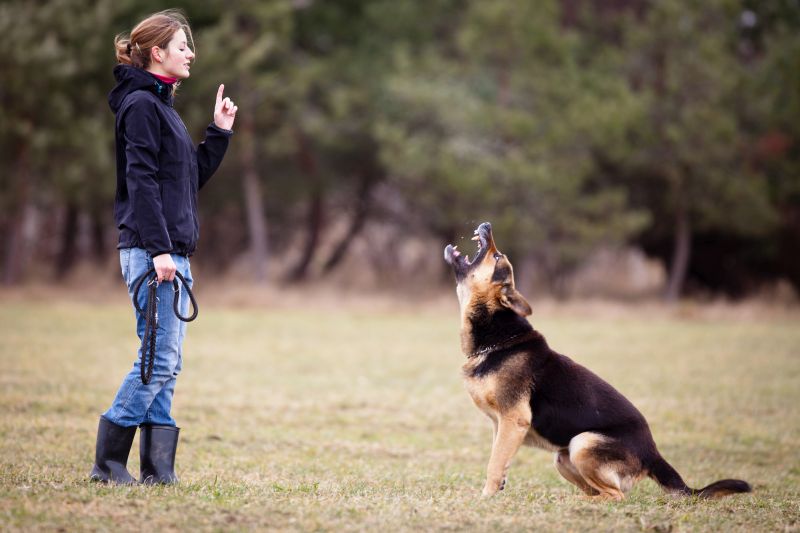
Working through canine aggression isn’t easy, but you can conquer it in most cases through positive, ongoing training with dedication and patience.
Embrace basic ground rules and avoid common missteps detailed below (don’t worry, we dig further into many of these points below):
Things You Should Do When Working with an Aggressive Dog:
- Get a thorough vet examination to ensure your dog’s aggression isn’t health-related.
- Seek out the guidance of a certified dog behavior consultant.
- Employ desensitization and counterconditioning training if appropriate.
- Make sure your dog is getting enough exercise and other canine enrichment activities.
- Maintain a calm demeanor around your pet.
- Use positive reinforcement and reward-based training techniques.
- Purchase and use a muzzle if your dog bites or you suspect he may.
- Set your dog up for success by working in a safe training space.
- Try to address or eliminate your dog’s triggers, such as providing more elbow room during meals or addressing his underlying anxiety.
- Use management tools and techniques, such as puppy gates, to keep your dog separated from people and other dogs if need be.
- Consider spaying or neutering your dog — especially if your vet or behaviorist suggests that his aggression may be sex based.
Things You Shouldn’t Do When Working with an Aggressive Dog:
- Do not put yourself or others at risk, which may mean leaving the training process to professionals if you don’t think you can do so safely.
- Do not punish aggression (especially growling — this is your dog’s way of telling you he’s upset or afraid).
- Do not employ outdated and counterproductive training techniques, such as dominance-based alpha dog training methods.
- Do not use aversive dog training tools, such as prong or shock collars — these will only exacerbate your dog’s fear and frustration.
- Do not touch or pick up your dog when he’s acting aggressively (doing so puts you at risk for a redirection bite).
- Do not expect a cure (through training and/or medication, you’re managing aggression, but the underlying trigger may still exist and require attention.)
Tip #1: Get a Vet Check
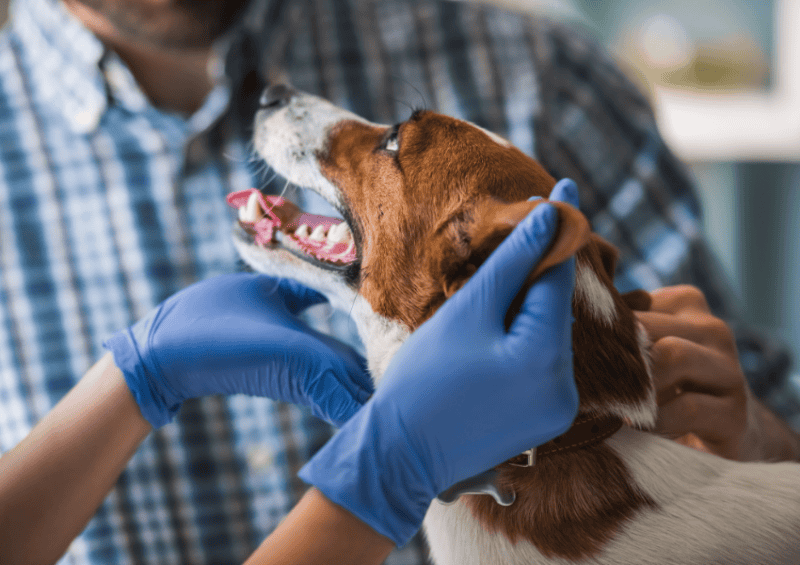
Aggression in dogs — even small ones — is a serious issue, and it is not one to take lightly. Resolving the problem will not only take a lot of time, effort, and patience on your part, but it will also require professional assistance.
The first thing you’ll need to do when working with an aggressive dog is to make an appointment for a thorough veterinary examination (be sure to explain your aggression concerns to your vet at the outset).
Like us, dogs can become more irritable when in pain or feeling “off.”
And this discomfort can (and often does) lead to aggressive behaviors.
If a health problem is causing your dog’s aggression, training is unlikely to help.
This means that taking your dog in for a physical is essential, even if your dog isn’t showing outward signs of pain or discomfort, as he may still be feeling crummy.
After ensuring that your dog is healthy, it is time to speak with a certified canine behavioral consultant.
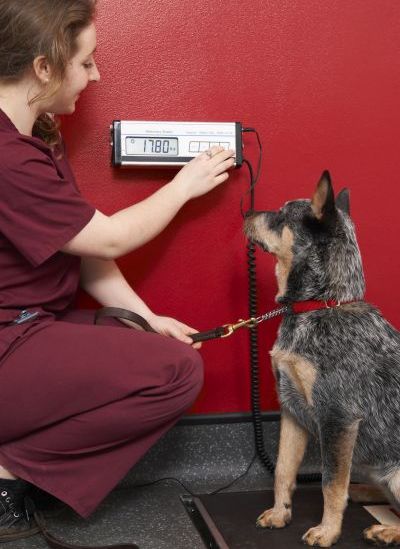
Tip #2: Get Help From a Certified Dog Behavior Consultant
Aggression is often difficult for an average to resolve, as there are often issues going “underneath the hood” so to speak. A certified dog behavior consultant (not an average dog trainer) will be able to properly assess why your dog feels the need to display aggressive behaviors.
They’ll also be able to help you develop a behavior modification plan that will allow you to work on your dog’s issues, whether he’s displaying aggressive behavior due to overarousal, fear, or anxiety.
Additionally, aggressive dogs can also be dangerous.
So, for the safety of you, your pet, and everyone else, always have a certified canine behavioral consultant assess your aggressive dog before you implement a training or management regimen.
To reiterate – it’s really important you are working with a certified dog behavior expert, specifically. Most dog trainers do not have the knowledge or experience to properly work with aggressive dogs, and it’s not unusual for a well-meaning but inexperienced trainer to offer advice that ends up making a dog’s aggression issues even worse.
Always err on the side of caution when working with an aggressive dog to keep yourself and others safe at all times.
Not only does this help prevent unnecessary injury to humans, but — because aggressive dogs may need to be euthanized in some cases — it can also save your dog’s life.
Tip #3: Ensure Your Dog is Living His Best Life
One of the first practices you can employ to help relieve some of your dog’s aggression is to do everything you can to ensure your dog is living his best life.
This means making sure he’s eating a good food and enjoying a ton of exercise and mental stimulation. Depression, frustration, and similar emotions will only complicate matters (heck, in some cases they may be a partial cause of your dog’s aggression), so do your best to take care of your dog’s mental and emotional health while waiting for professional help.
Some biting and aggressive behaviors can stem from frustration, signaling your dog’s needs aren’t being met. Ask yourself:
Is my dog getting enough exercise?
Most adult dogs needs somewhere around an hour of light exercise per day, with talking and playtime. However, high drive or high-energy dogs will certainly need much more than that. Talk to your vet about what kind of exercise your dog needs based on his breed type and individual drive. While some of this exercise quota can happen inside, the majority should happen outside, as your dog needs the chance to explore the world outdoors.
Is my dog getting enough playtime?
Besides straightforward walks, your dog needs a chance to play! This doesn’t have to be with other dogs – playtime with you can be just as fun. Make a habit of grabbing your dog’s favorite ball or squeaky toy and playing each day, ideally with several 5-10 minute play sessions a day.
For dogs who love to chase prey, try using a flirt pole, which can incorporate chasing stimulation play as well as exercise.
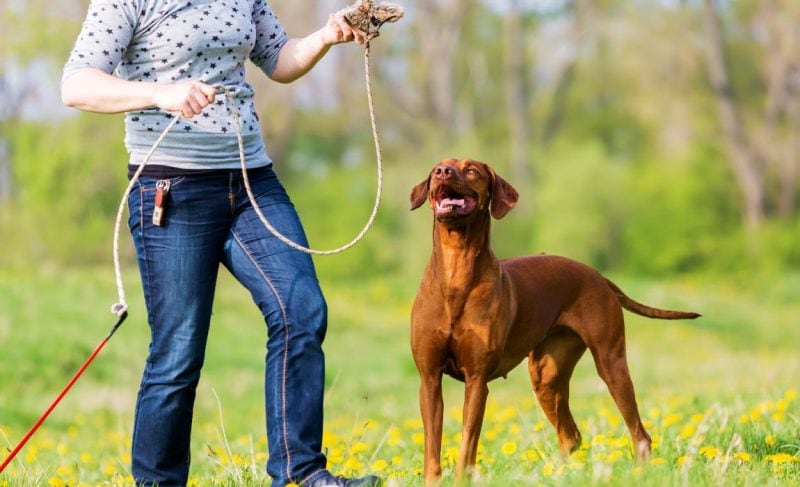
Is my dog getting enough mental enrichment?
Nearly all owners know that their dogs need exercise. But many don’t realize that mental enrichment is just as essential – maybe even more than physical exercise. Your dog needs the opportunity to practice his natural instincts and exercise his brain!
We have an entire guide on enrichment activities for dogs, but a few examples of great enrichment options include:
- Snuffle mats. Snuffle mats are fabric mats mimmicking grass that you can toss kibble onto, allowing your dog to sniff and practice foraging.
- Frozen kongs. Frozen kongs are rubber toys that can be stuffed with peanut butter, yogurt, or wet food and frozen to create a dog popsicle that your dog will spend at least 30 minutes licking and lapping up. Licking is a very self-soothing activity for dogs, so it’s a great way to help calm a stressed canine.
- Lickimats. Similar to Kongs, licking mats can be spread with yummy wet treats for your pup and then frozen for optimal enjoyment.
- Chews. Many owners make the mistake of trying to stop their dog from chewing altogether. But, chewing is a very satisying and relaxing activity for dogs. The key is to ensure they are chewing the right things. Check out our collection of the best dog chews and let your dog nom away.
- Shredding. A lot of dogs go nuts for shredding. Shredding allows a dog to mimmic the dissection process of catching prey. You’ll want to keep an eye on your dog while he shreds to make sure he’s not eating anything bad, but it’s a very satisfying and worthwile activity for many dogs. I’d suggest starting with empty toilet paper rolls, paper towel rolls, and small cardboard boxes. If your dog is hesitant, try throwing some treats inside the item!
- Scavenger hunts. My own dog is absolutely in love with scavenger hunts! Hide a bunch of stinky treats around the house and let your dog sniff and snuff out the goodies. Sniffing and nosework games are often fun, relaxing, as well as very exhausting for dogs.
Tip #4: Incorporate Management Techniques
Management techniques refers to methods and strategies that manage your dog’s aggressive behavior, rather than relying on behavior modification. Basically, management techniques are used to prevent your dog’s behavior from escalating further or hurting someone.
Ultimately, it’s best to use management techniques in conjunction with behavior modification (with the guidance of a professional behavior expert). But, if you’re having a hard time getting an appointment with a behaviorist, management techniques can do wonders for helping you feel safe and in control of your situation.
Some examples of management techniques to use with aggressive dogs include:
Gates
Indoor dog gates are serious lifesavers. They are an affordable, easy, and effective tool for managing a dangerous dog. They’re also incredibly versatile. Put up gates near the entryway or foyer of your home to prevent an aggressive dog from dashing out the door (and potentially biting a stranger outside).
Use gates to separate a recourse-guarding dog so that he can eat his food safely in peace. Or, use a gate to keep a dog in a side room while you have guests over, keeping guests safe while still giving your dog a chance to be desensitized to guests while incorporating some methods to stop a dog from barking at guests and games like treat and retreat.
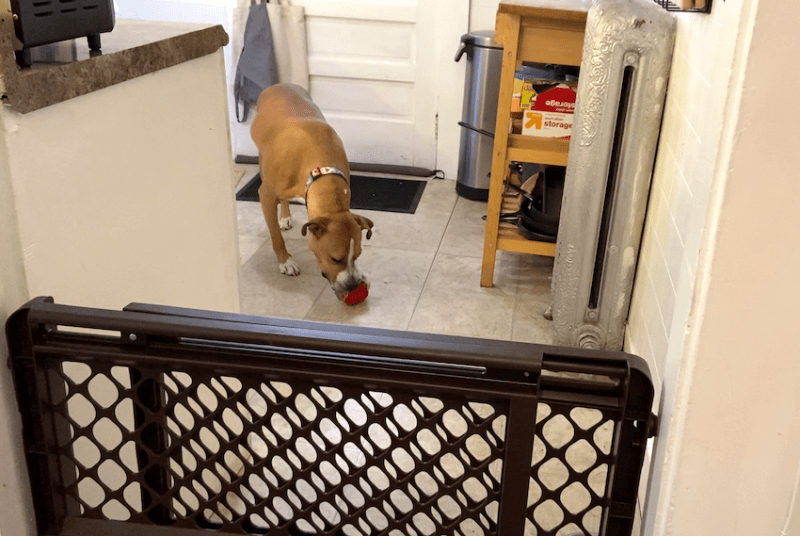
Crates
Crates can be used in a similar way to gates, but they aren’t appropriate for long periods of time. While a dog can spend nearly the entire day in a safe, gated room (with plenty of enrichment activities), it’s not appropriate to keep a dog crated all day.
Leashes
If you have an aggressive dog, they need to always be leashed in public, with no exceptions. If you don’t have a private fenced-in area where your dog can frolic off-leash, consider visiting dog parks in the early or late hours when the area may be empty or – if allowed – use other public fenced-in areas like ballparks, playgrounds, or tennis courts. Just make sure to always pick up after your pooch! If none of those options work, consider trying SniffSpot, a service that allows you to rent out another person’s private yard for an hour or so of safe, off-leash fun.
Muzzles
We’ll go into more details about muzzling later, but know that muzzles are an easy, simple, fool-proof way to keep humans and dogs safe, preventing a dog from biting someone (or heck, biting their owner).
“Do Not Pet” Gear
If you have a dog breed that is not commonly known for aggression (such as Golden Retrievers or Labs), you may encounter an issue with children and strangers barreling up to your dog for pets.
For a fearful reactive dog, this is terrifying and exacerbates aggression. In addition to simply vocalizing to strangers not to pet your dog, some owners choose to use warning leashes, “do not pet” harnesses, or bandanas to keep strangers at bay.
Tip #5: Evaluate the Severity of Your Dog’s Aggressive Behaviors
Dogs show aggression in many ways, including growling, lunging, and biting, among others.
None of these behaviors are fun to deal with, but biting is obviously the most extreme, troubling, and dangerous manner in which aggression manifests.
These behaviors often seem to come on suddenly, but they actually represent the final rungs of something called the canine ladder of aggression.
This behavioral scale demonstrates the progressive and escalating nature of aggression.
In other words, your dog will likely exhibit a sequence of signs and symptoms that attempt to convey his discomfort.
This means that by the time your dog starts growling at you or biting, he’s been feeling stressed, frightened, or anxious for quite a while.
And he’s probably displayed some subtle cues that you may have missed.
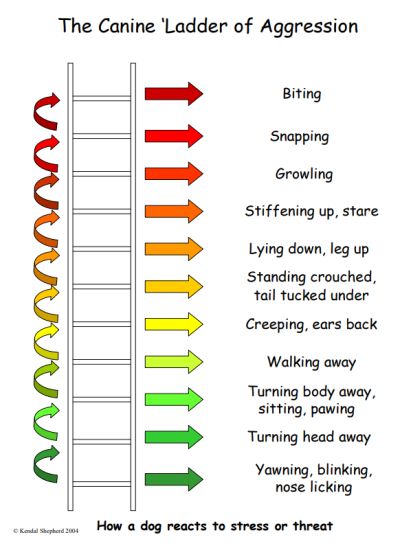
For example, your dog may initially try to convey that something or someone is bothering him by doing things like avoiding eye contact or yawning. If he continues to feel frightened or threatened, he may progress to walking away or tucking his tail. If this doesn’t work, he may adopt a stiff body posture, or begin growling, snapping, or biting.
However, it’s important to understand that this escalation of aggressive behaviors isn’t always linear, so you must take a canine’s cues seriously, regardless of how mild they may seem.
Which leads us to our next tip – understanding dog body language.
Tip #6: Learn Dog Body Language
As humans, we largely communicate verbally. We tell someone when they are making us uncomfortable with our words. But dogs don’t have this luxury! Instead, dogs (and most all other animals) rely much more heavily on body language to communicate.
These vastly different communication styles can pose a bit of a problem when we share our households. As humans, we’re often so used to relying on verbal communication that we aren’t always perceptive of more subtle body language cues our dogs are giving off.
It’s not unusual for owners to miss non-verbal signals a dog is feeling nervous, such as “whale eye” seen below:
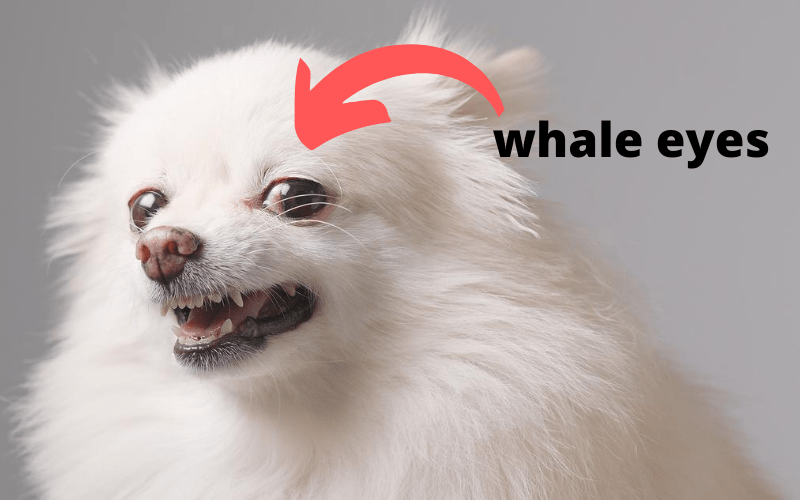
As our dog’s caretakers, its our job to learn their language so that we can better assess when they are feeling uncomfortable. Dogs can’t learn to speak English, but we can learn to interpret dog body language!
Make sure to check out our full dog body language guide to learn how to communicate with your canine. But for the quick and dirty version, here are several clear indicators of a stressed dog saying “I need space”:
- Yawning or nose licking
- Shifting focus away from you
- Angling body away
- Retreating
- Ears turning back
- Standing crouched with the tail tucked between legs
- Stiffening or tensing up
- Whale eyeing (showing the whites of eyes)
- Unbreakable stare
- Baring teeth
- Growling
- Harsh barking
- Lunging or charging
- Muzzle punching (striking you with their muzzle, close-mouthed)
- Snapping
- Biting
In most instances, a dog gives plenty of warning before biting.
So, if you note any of the signs or symptoms above, the first thing you’ll want to do is back away and give your dog some space and time to decompress.
You should also note what preceded the change in body language to help aid in the solution. Don’t react or punish your dog. This can worsen the issue and put you at unnecessary risk.
Tip #7: Consider Why Your Dog is Displaying Aggression
There are several different types of dog aggression, which is why it’s critical to work with a canine behaviorist and your vet to determine the root cause of your dog’s behavior.
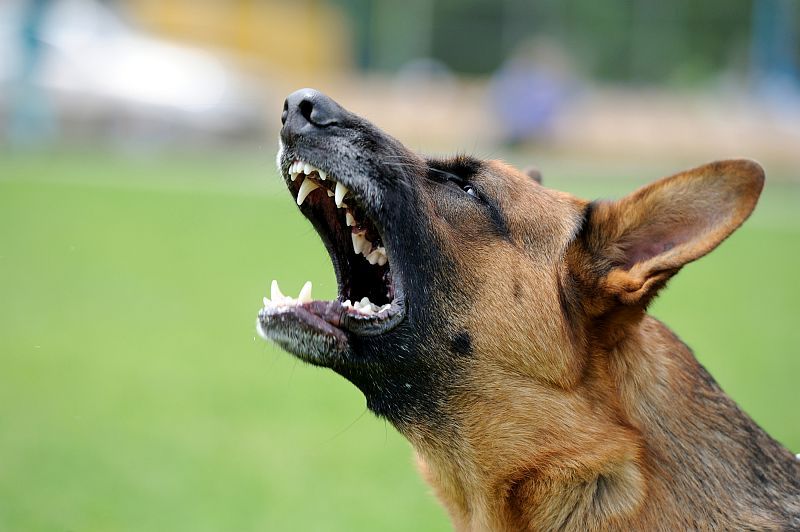
While it’s a bit of a semantic distinction, it is important to note that the term “aggression” is often somewhat misplaced, as these dogs are often acting in a defensive manner. They’re trying to clear space between themselves and a perceived threat or discomfort, whether it’s something frightening or a risk to their resources.
Think about it: When you’re overwhelmed, what do you do? Call up a friend? Take a walk?
Your dog doesn’t exactly have those options, so he expresses discomfort by acting like… well, a dog.
He can’t voice that he’s feeling scared, but he can certainly express his fear or displeasure by whale eyeing or flashing his teeth — universal signs for “back off.”
A few of the most common triggers for aggressive dogs include:
- Fear: Fight or flight is the most basic instinct in humans and dogs alike. When your dog is scared, he’ll likely try his darndest to flee the situation, but if he’s forced to interact with a threatening trigger, he may feel the need to defend himself — even by using his teeth, if need be. Fear is one of the most common causes of aggression, and it results in countless unnecessary bites.
- Anxiety: Anxiety is closely related to fear, so it isn’t surprising that both emotions can trigger aggression. Nevertheless, anxiety is often a more general emotion that sticks with dogs whether or not a trigger is present; fear, on the other hand, is almost always caused by a tangible entity — something you can point at. But ultimately, the result is the same as when dogs feel fear.
- Illness: When your dog isn’t feeling his best, he may be extra grumpy around the house, grumbling when it comes time to move or snapping when touched or picked up. He may also be less patient with young children or other dogs. This is frequently behind aggression in older dogs, but it can occur at any age, so it should always be considered.
- Resource Guarding: Some dogs feel insecure about items of high value, such as food, bones, or toys. These dogs may act out rather explosively if they feel as though you or another dog may steal their treasured items. This dangerous behavior can lead to growling, snapping, or even attacking those thought to be threatening the object. Teaching your dog to “Leave it” or “Give it” can reduce the likelihood of resource guarding issues, though these issues can also arise later in life, especially in multi-dog households.
- Lack of Stimulation: Not enough exercise or interaction can cause frustration, which may lead to many unwanted behaviors in dogs, including irritability and aggression. There’s just no way around it: Dogs are active, social creatures who need daily exercise and interaction with their favorite humans. So, be sure to provide your pooch with plenty of canine enrichment opportunities.
- Sex-Related Aggression: Unaltered dogs may become quite aggressive in sexual situations. This most commonly occurs between male dogs who’re in the presence of female dogs in heat, but it can manifest in many different ways. This is one of the most compelling reasons to consider having your dog spayed or neutered.
- Idiopathic Aggression: Idiopathic aggression refers to scenarios in which the cause of a dog’s aggression remains unknown. Because there’s no clear, identifiable cause of idiopathic aggression, it is particularly dangerous, as it cannot be predicted. Fortunately, idiopathic aggression is exceedingly rare.
Many of these root causes of aggression can be avoided through training and socialization during puppyhood, but sometimes, a traumatic experience can set you back a few steps. And this may mean you have to revisit the basics later in life.
This isn’t anything to panic over or feel guilty about. It happens. All you can do is reset and move forward positively with your pup.
Tip #8: Learn the Difference Between Aggression and Reactivity
Aggression is sometimes confused or lumped in with reactivity, though there are marked differences between the two behaviors.
The term “reactivity” applies to dogs who overreact to various types of stimuli.
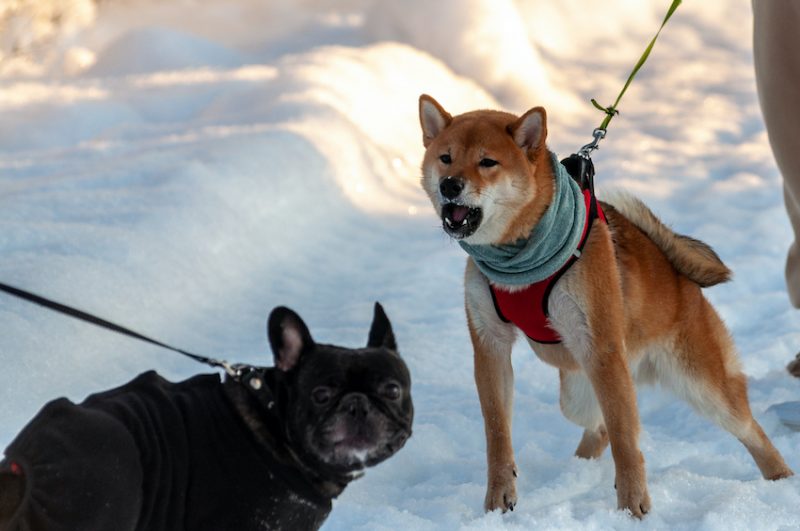
Ultimately, reactive dogs tend to be dogs who are extremely sensitive to their environment and to various stimuli. This extreme sensitivity can be the result of trauma, lack of socialization as a puppy, or can be partially due to genetics.
A few of the most common triggers for reactive dogs include things like:
- Strange people
- Other dogs
- Loud noises
- Bicycles, scooters, and baby carriages
But really, just about anything can serve as a trigger. Some dogs have a number of triggers, while others are only bothered by a single type of stimuli.
It’s also important to note that some dogs may be reactive in some situations, but not others. For example, many dogs become reactive during leashed walks, while they remain relatively calm when not tethered in this manner.
Reactive dogs may be labeled by others as “aggressive dogs” because they display aggressive behavior when confronted with a trigger that sets them off. But, as many owners of reactive dogs will note, they are often sweet, cuddly love bugs when in the safety and comfort of their own home.
While some may use the term of “aggressive dog” in relation to a reactive dog, others prefer to label a dog as aggressive when they are more or less in a constant state of stress and agitation, regardless of triggers.
Some aggressive dogs are generally scared, stressed, frustrated, or in pain, which leads to hostile behaviors. They may not exhibit aggression that’s associated with a straightforward, obvious trigger. Instead, their aggressive outbursts can happen at any time.
Put another way, dogs that one might refer to as “generally aggressive” suffer from on-going discomfort, while reactive dogs only act out in the presence of their triggers.
It’s crucial to know which group your dog falls into before starting a training regimen, as these problems may require different training and management approaches.
For example, a reactive dog may benefit from desensitization training, while a dog with aggression issues needs a more comprehensive approach. You’ll need to identify the cause of the unwanted behavior before moving on to training solutions to keep everyone happy and healthy.
Tip #9: Identify and Avoid Your Dog’s Triggers
Identify and avoid anything that triggers your dog. If, for example, your dog freaks out when he sees other dogs, avoid walking him when there are a lot of other dogs out and about or pick a different park with fewer canines.
At the very least, try to keep objects like cars or bushes between your dog and the things that upset him.
Many owners make the mistake of thinking they need to correct their dog for barking and lunging at other dogs. But in actuality, anytime your dog is given the opportunity to practice the unwanted behavior, it is being reinforced through repetition. The best method is to avoid putting your dog in a situation where he feels the need to react and display aggressive behaviors to feel safe.
This usually means getting more distance (sometimes a lot more distance) from the triggers while practicing counter-conditioning and desensitization. Check out our article on walking a reactive dog to learn more, or watch our reactivity hacks below.
Tip #10: Journal About Your Dog’s Behavior
For some owners, it can be extremely beneficial to keep a journal about your dog’s aggressive behavior.
Try to note anytime he displays aggression, as well as any stimuli associated with the event (such as the presence of other dogs). We even have a reactive dog tracker journal that you can download to help monitor your dog’s behavior (although it’s specifically designed to monitor reactivity, not general aggression).

Some things to note in your journaling include:
- Time of day
- Trigger / stimuli
- Antecedent (aka what happened preceding the aggressive behavior)
- Consequence (aka how did you respond to the aggressive behavior?)
- Weather (was it hot, raining, snowing, etc)
This kind of data can be incredibly helpful, as these details will often help your behaviorist spot patterns in your dog’s behavior.
After collecting some data on when and where your dog’s aggressive incidents occur, you yourself may even begin to notice some patterns. These patterns may help clue you into why your dog is resorting to aggression or — at the very least — may allow you to incorporate some specific management strategies in high-risk situations.
For example, it’s not unusual for young dogs to experience “witching hours” where, during dusk, sunset, or the early evening, they’ll get especially hyper and crazy. Some dogs may become especially aroused and resort to biting and nipping. Once you recognize that these nipping incidents happen most often during the dog’s “witching hours,” you can employ the use of crates, gates, or distractions through frozen Kongs or chews to prevent the behavior from escalating (or potentially stopping it altogether).
Tip #11: Muzzle Up
We’ve already talked about several of our most recommended management tools for aggression, but muzzles are so essential that they get their very own section!
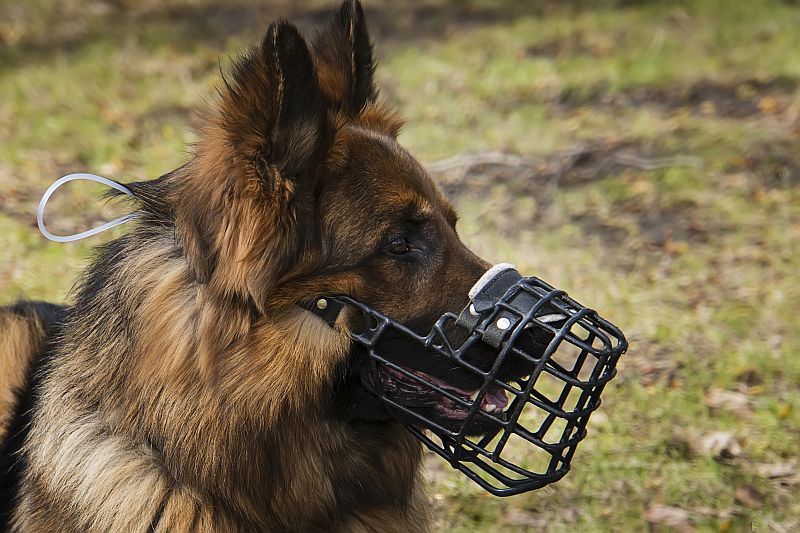
It’s a shame there is such a stigma around muzzles, because they are a total life-saving game-changer for any aggressive dog.
A muzzle allows your dog to safely go out in public and enjoy walks outdoors without any risk of someone getting hurt. It’s an amazing failsafe that all owners of aggressive dogs should employ. Seriously, muzzles are amazing invetntions.
Specifically, you’ll want to purchase a secure basket-style muzzle that will allow your dog to pant and cool himself off properly. A dog should be able to drink, pants, and even take treats via an appropriate basket muzzle (the Baskerville Muzzle is our favorite).
See our full guide on muzzles to see our favorite picks and learn how to desensitize your dog to a muzzle.
This is a sponsored placement, in which an advertiser pays a fee to be featured in this article. Learn more
Muzzles that close your dog’s mouth completely should not be used. These are groomer muzzles and are only suitable for very short periods.
I suggest using muzzles even on dogs that are not aggressive but are simply untested or inexperienced with certain populations. For example, my own dog has never bitten a child, but he doesn’t have a lot of experience with them, so whenever I have small children visiting, I’ll muzzle up my own dog Remy to ensure I don’t need to worry about any mishaps.
I know it can be a bummer to put your dog in a muzzle, but it’s the easiest way to be with your dog and have 100% confidence no one will get bitten. If you don’t like the look of a standard muzzle, consider decorating your dog’s muzzle with colorful duck tape or purchasing a specialized Buma muzzle that features bright and colorful custom neoprene options (or consider making a DIY muzzle yourself).
You can’t just strap a muzzle on your dog suddenly — doing so may cause him to freak out and be afraid of the. muzzle
Instead, you’ll need to “introduce” your dog to the muzzle and spend some time helping him develop a positive association with it. Essentially, you’ll need to let him investigate it and then wear it for brief, but increasingly longer periods of time, all while giving him lots of tasty treats.
By doing so, your dog will likely learn to wear the muzzle without putting up much of a fuss.
Tip #12: Consider Spaying and Neutering
Many individuals used to commonly assume that dog aggression relates to neutering – and it’s possible this idea was pushed in part to increase spay and neutering rates. More recent research has shown this isn’t always the case, but in some situations, spaying or neutering may help remedy hormone-based aggression.
Make sure to talk to your vet about the pros and cons of spaying or neutering your dog. If your vet and/or behaviorist recommend getting your dog snipped, it might be an easy and simple way to resolve your dog’s aggressive tendencies.
Tip #13: Don’t Punish an Aggressive Dog
When working with an aggressive dog, it’s essential that you avoid using punishment or aversive-based practices. This includes avoiding the use of:
- Prong collars
- E-collars
- Leash corrections or leash pops
- Alpha rolls
- Yelling or scolding
Why are these methods not recommended for aggressive dogs? Well, most dogs display aggressive behaviors as a result of fear or anxiety. Using force-based methods can increase your dog’s fear, damage your relationship with your dog, and escalate an already tense situation.
We promise, your dog is not displaying aggression because he thinks he is the alpha dog – that theory has long been debunked and is based on very bad science.
Instead, focus on helping your dog feel safe, build your dog’s confidence, and use a combination of redirection, positive reinforcement, and counter-conditioning to resolve your dog’s behavior issues.
A good dog behavior expert can help you employ a plan that works on these goals. If a self-titled, non-certified behaviorist suggests using fear or pain-based tools like those listed above, run the other way. In many situations, long-term use of such tools can increase aggression and lead to serious fallout down the line that could result in your dog needing to be euthanized for behavior issues.
On top of generally avoiding punishment when working with aggressive dogs, you’ll want to be especially careful to never chastise or correct a dog for growling.
Growling is one of the few universally-known, obvious, verbal ways our dogs can communicate with us. It’s the warning that comes before a bite.
Punish your dog for growling, and next time they’ll skip growing and go straight to a bite, since they’ve learned they get in trouble for growling.
Although it can feel like you should punish a growling dog, you never want to punish your dog for communicating. Your dog needs to be able to indicate when they are feeling nervous, scared, or uncomfortable. If the dog can’t communicate and doesn’t get help, they have no option other than to escalate to a bite.
Tip #14: Give Your Dog Space
It’s not unusual for an owner to bring a new dog home, go to kiss and hug the dog, and be shocked when the dog snarls or bites them. But to anyone who understands dogs, this shouldn’t be a surprise at all!
Most dogs do not like being hugged or kissed.
And the vast majority definitely don’t want to be smothered when they are in their crate or on their bed relaxing in peace.
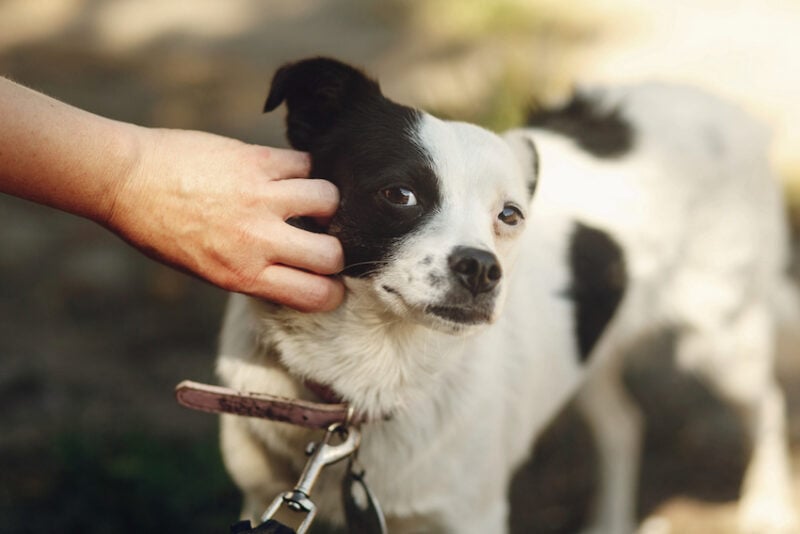
If your dog is responding aggressively to your approaches and offers of comfort, take a step back. Your dog is asking for you to respect his space. Instead of approaching your dog to pet him, let him come to you for affection. Practice some of our approaches for getting a scared dog to trust you and prove to your dog that he can feel safe in your presence.
Try to consider your dog’s perspective – would you be happy if someone jumped onto you while you were sleeping and rubbed themselves all over you? Probably not!
Respecting your dog’s space is essential for all dogs, but it’s especially vital for a dog who is new to your home. A new rescue or rehomed dog has likely had his entire life turned upside down. Give your dog a safe space to decompress and take in his new home. It may take several weeks or even months for your dog to truly feel safe and at home in your presence, especially if they have spent a long time at a shelter or were not in a good environment previously
Tip #15: Don’t Be Afraid of Trying Behavior Medications
Easing a dog’s fears and anxieties goes a long way in handling canine aggression.
If your vet or canine behavioral specialist suspects these are the root cause of your dog’s aggression, one or both may suggest using some type of calming aid or medication.
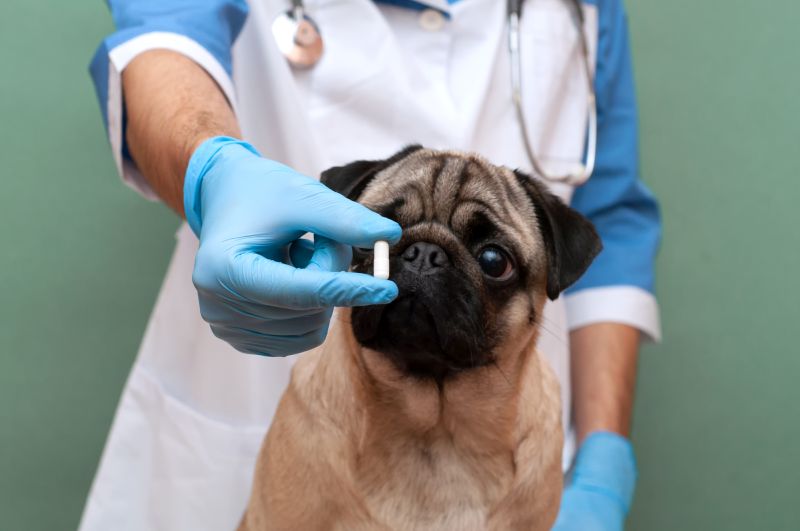
Your vet may, for example, prescribe a medication such as Xanax or Prozac to help alleviate some of your dog’s stress. However, medications are rarely silver bullets, and they should typically be used in tandem with training for best results.
Popular “natural” treatments include things like aromatherapy, supplements, or CBD-based products.
These types of products can calm down dogs in some cases, though you should use caution and seek out dog-specific products only. Also, always run any prospective product by your vet first to be safe, too, as many “natural” products (especially essential oils) are dangerous and can cause neurological responses like seizures or lethargy.
Tight-Fitting Compression Garments
Some anxious dogs find that compressive garments (such as the famous Thundershirt) provide relief — especially in response to temporary stressors like storms, travel, and fireworks.
Thundershirts are likely the most popular compressive garment on the market, but an old T-shirt may work in a pinch. For that matter, you can make your own DIY Thundershirt if you’re crafty.
Other dogs may appreciate a weighted backpack or a bed they can burrow into. Just be sure that you monitor your dog when using new products to avoid any accidental injuries.
Nutritional Supplements

As mentioned, your dog’s health can affect his behavior. So, ensuring your dog is getting the vitamins and minerals he needs offers peace of mind during training.
You want your pooch feeling his best, right?
So, in addition to selecting and feeding your dog a nutritious food, be sure to discuss things like Omega-3 supplements and vitamins with your vet. These types of supplements may do things like reduce bodywide inflammation and ward off deficiencies that make your pup feel crummy.
You can also look into your doggo’s gut health to aid in his nose to tail health. Prebiotics and probiotics can help whip your dog’s GI tract in tip-top shape, leaving him feeling more energetic and potentially less crabby.
Just remember that no supplement is a magic pill, and proper training is still crucial in your dog’s success.
Tip #16: Protect Yourself Legally
There’s no denying that having an aggressive dog can be scary – not just in terms of the dog’s behavior, but in terms of the legal dangers as well. If your dog seriously injures someone, you could be liable.
This is why management strategies are so essential- anything you can do to reduce the risk of your dog biting somone is essential. Consider looking into your home owner’s insurance policy or renter’s policy to see if you can get some extra coverage for a problem pup.
In addition to the management tips outlined above, there are some other more legally-helpful tools you can employ to protect yourself, such as:
- Warning Signs. Some owners also employ the use of dog warning signs around their property to let trespassers know that an aggressive dog is on the premises. Ideally, this will limit the risk of strangers coming onto your property and getting bitten. At worst, it might limit any regal ramifications and could even prevent your dog from being put down if he bites someone.
- Security Cameras. It sounds crazy, but on more than one occasion we’ve heard of neighbors purposefully antagonizing an aggressive dog, possible in hopes of getting the dog euthanized after being bitten. To protect you and your dog from spiteful neighbors, consider setting up security cameras on your property. That way, if a bite does end up occuring, you’ll have evidence to illuminte the truth of what happened.
- High Fence. Owners of aggressive dogs will likely need to double down on a great outdoor dog-proof fence. Ideally, something sturdy, high, and escape-proof (if your dog is a Houdini hound). If you have fencing that the dog can see through, exacerbating territorial aggression, consider adding privacy screening to the fencing.
Tip #17: Set Realistic Expectations
Helping a dog feel more safe and confident takes time. Don’t expect overnight magic – expect months of hard work. However, with professional help, practice, management, and medication (in some cases) you will see improvements.
Journaling is so important with aggression cases because improvements can feel so small and may go un-noticed day-to-day. But, if you employ some of the methods here and follow the guidance of a certified dog behavior experts, you will absolutely see your dog become calmer, happier, and more at ease.
It can be easy to feel frustrated and dissapointed with an aggressive dog. Sometimes it may feel like you got jipped – dogs aren’t supposed to be like this, are they?
The truth is you are not alone. Many owners struggle with their dog’s aggressive behaviors, but few are eager to talk about it.
I once heard a behavior expert quote a line that stuck with me:
Your dog isn’t giving you a hard time, he is having a hard time
No dog is capable of being intentionally malicious or mean. When a dog displays aggressive behaviors, it’s in order to protect himself out of fear, or because he is completly overwhelmed, overaroused, and frustrated.
Your dog is so much more than his aggression.
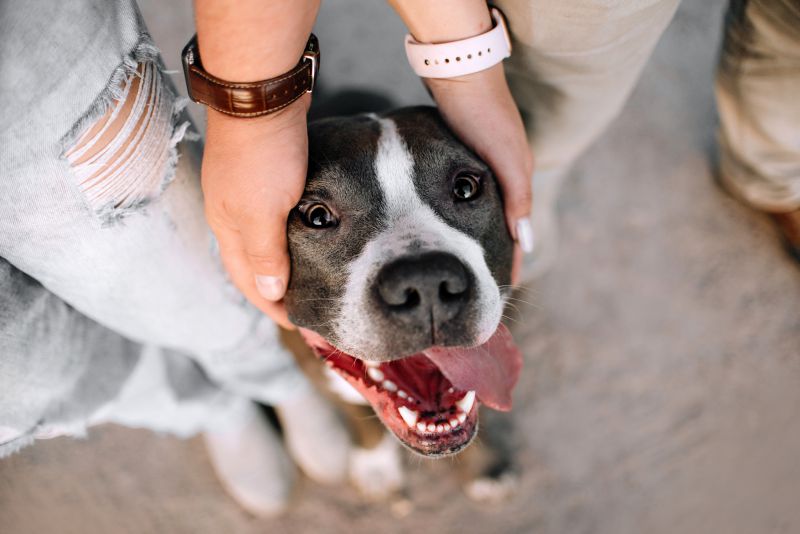
Do your best to sympathize with your dog’s position and understand he is doing the best he can do, in this moment.
There is a fair amount of social pressure to have a well-behaved dog. But let me be the one to take this pressure off of your shoulders. As long as your dog is happy and has his needs met, he does not need to love strangers or other dogs. Plenty of dog aggression stems from issues outside of an owner’s control, and as long as you and your dog are happy and safe, all is well.
Of course many owners choose to work with their dog’s through their aggression issues so that the dog can have more opportunities and experiences. Or, because the current situation is not liveable for the family.
Whatever your situation is, just know you aren’t the only one experiencing this, and that there is help out there!
***
Aggression in dogs can be scary, but you can get through this with the proper mindset, training, and professional behavior assitance. Most aggressive dog behaviors can be mediated through ongoing behavior modification and management.
Do you have an aggressive dog? Have you used any of the methods listed above to help? Have you contacted a proessional? Share your experiences in the comments!
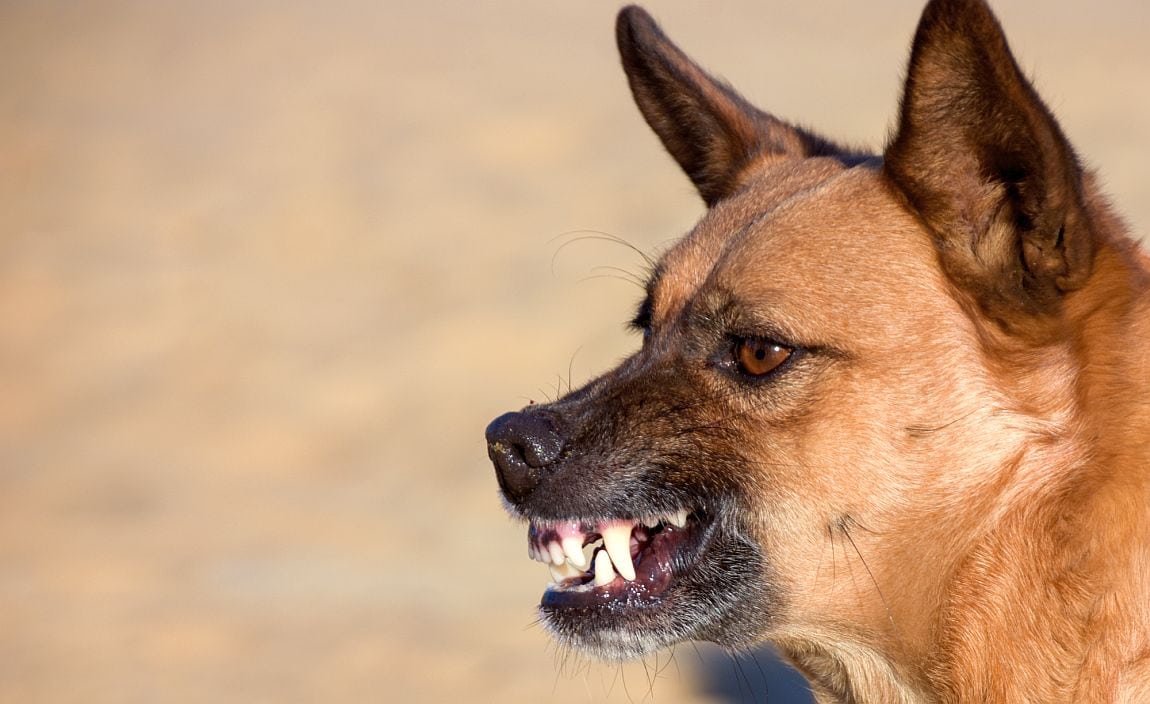


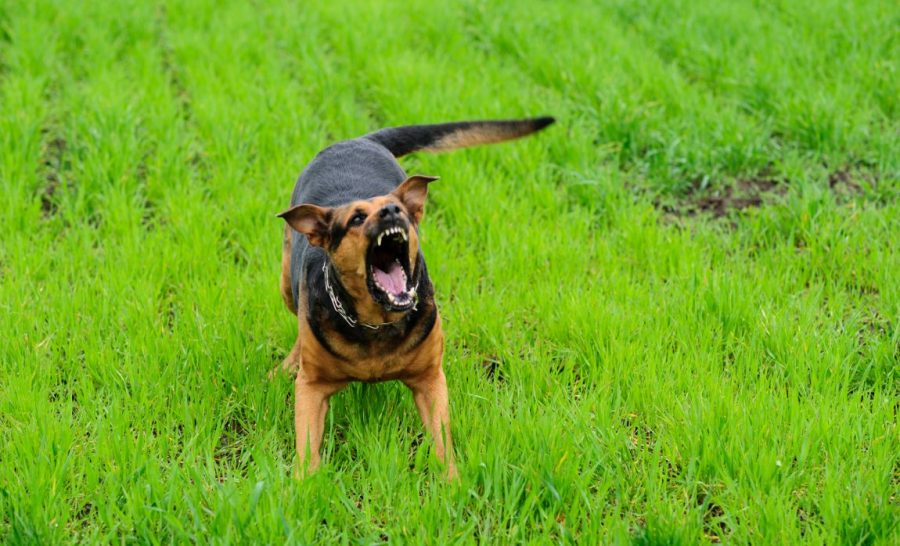


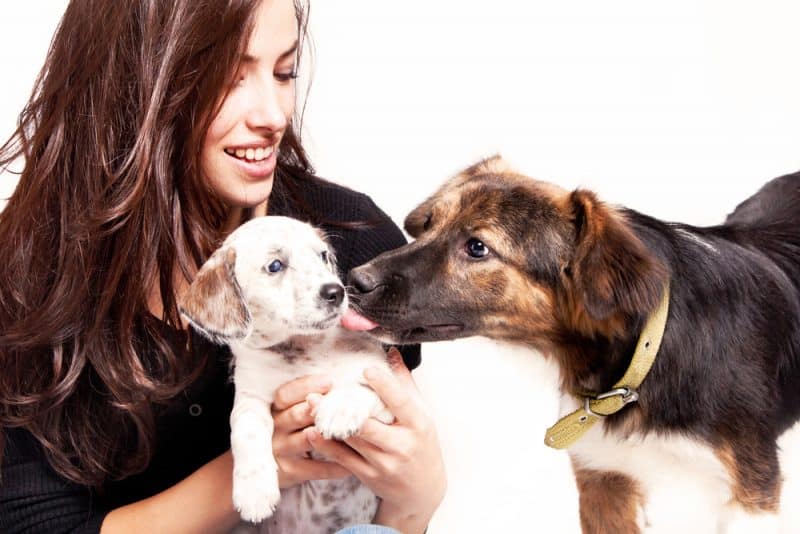
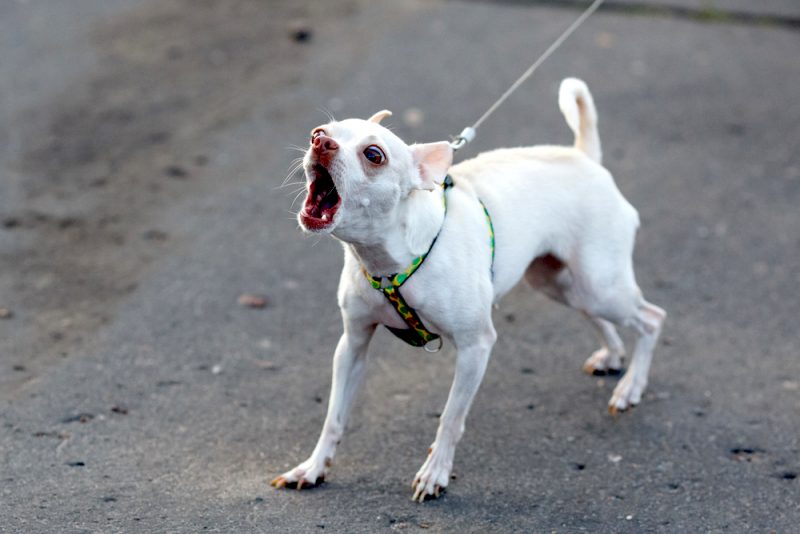
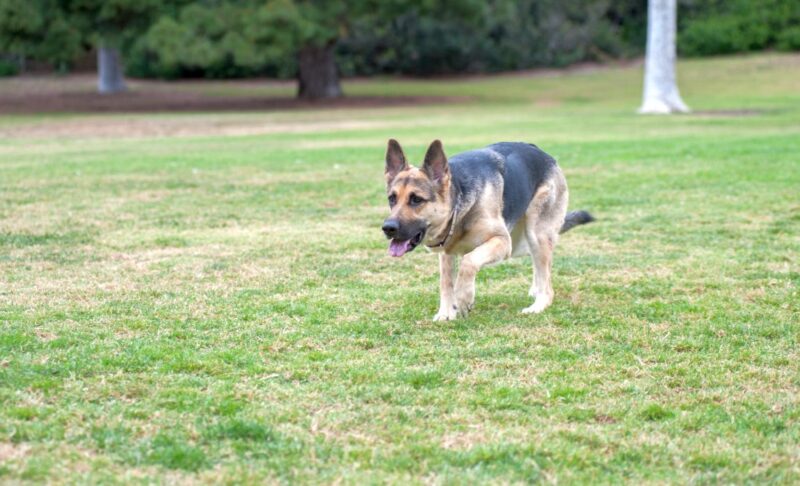
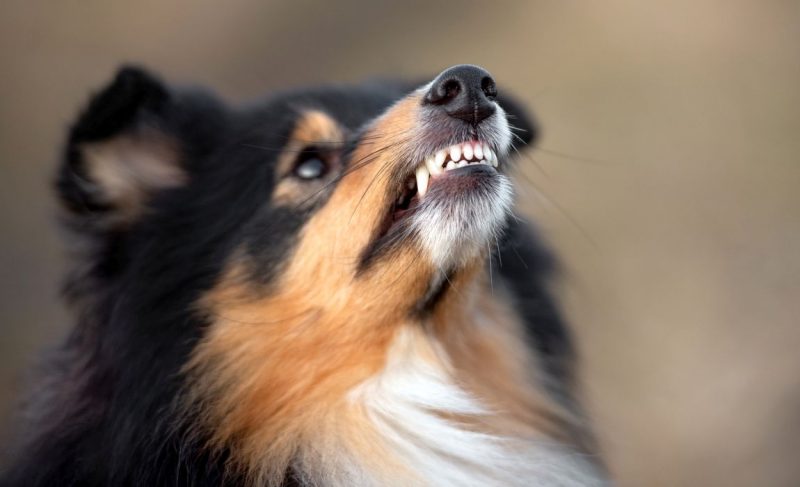
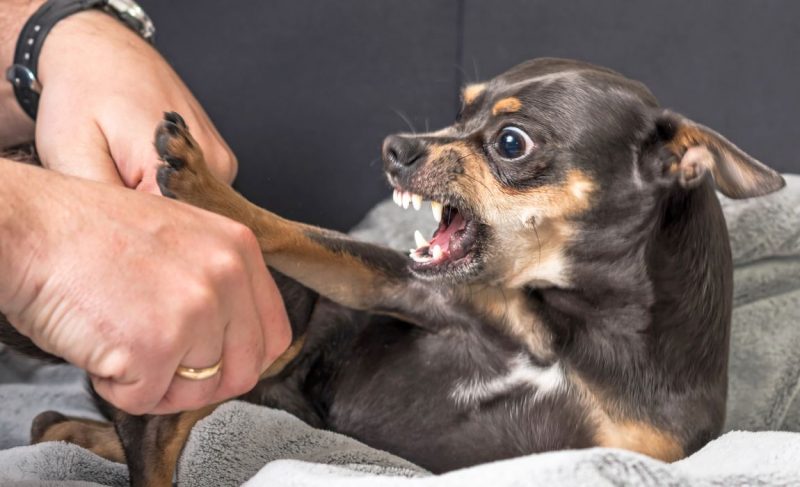
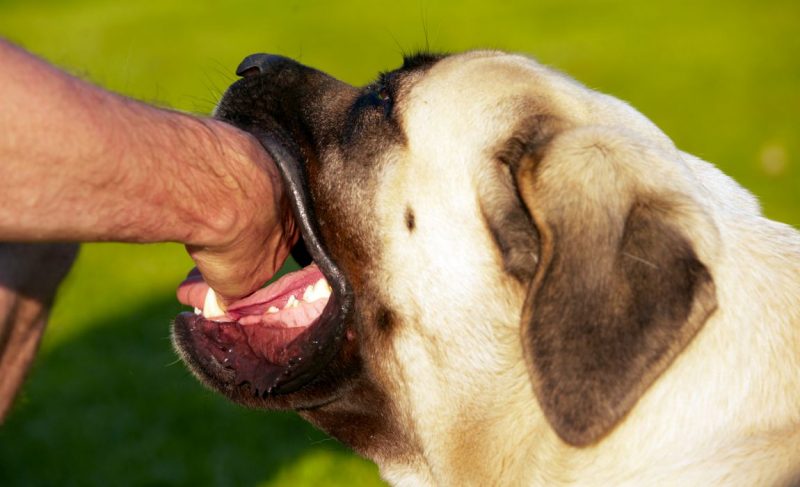
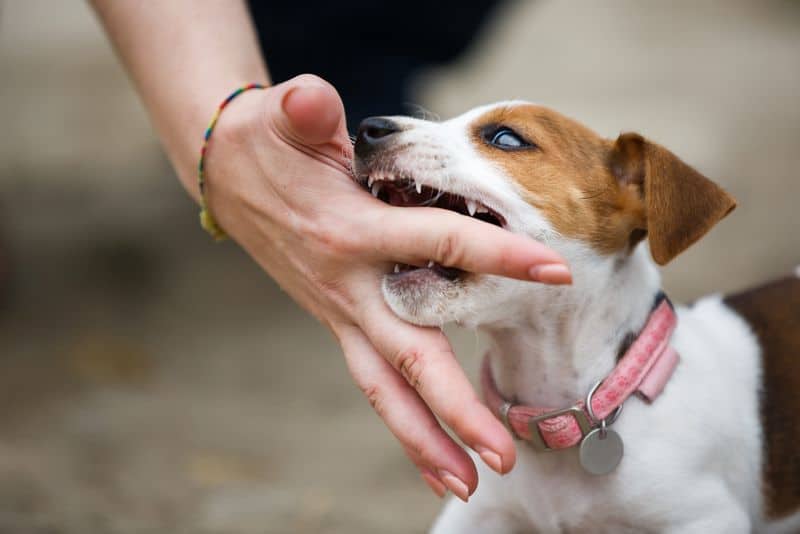

Leave a Comment